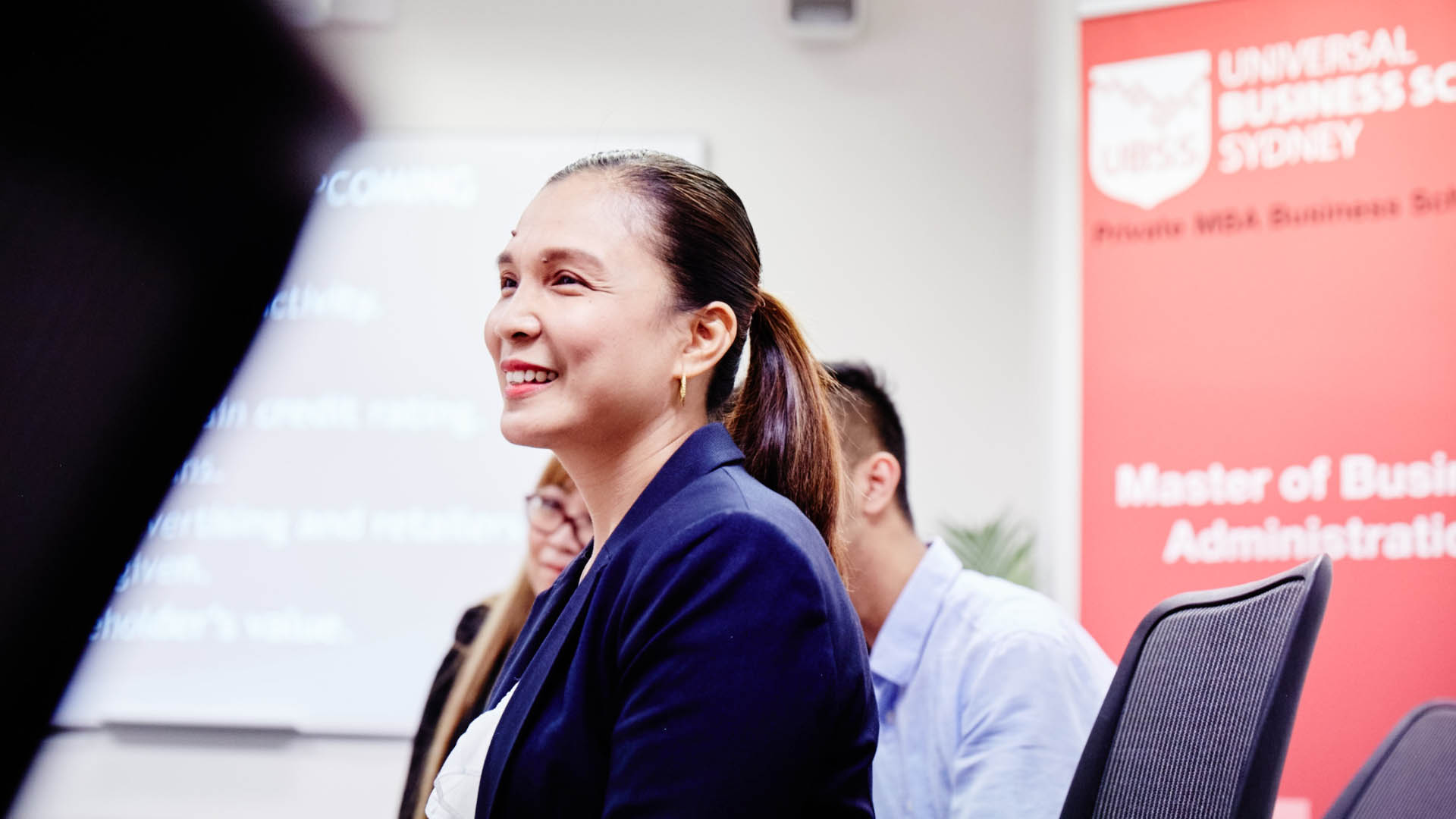
ABSTRACT
It has been around for centuries – but is now the new essential in tertiary courses – WIL is making deep inroads into tertiary education at almost all levels. But what is it and why has it long been part of UBSS’s approach to business education?
WIL IS UBSS’S PREFERRED ACADEMIC DELIVERY APPROACH
The ideal is that there is a practical, work-based element to everything we teach in a business school ensuring students are well versed and ready for the work force (and all it has to throw at them) on graduation. Every effort is made to ensure this focus.
Teaching staff
Teaching staff are chosen carefully – not only with regard to qualifications – with regard to workplace experience and expertise. The careful matching of professors with subjects has paid dividends at UBSS in recent years. Prior to COVID-19 the School was at capacity with in excess of 1,000 full-time MBA students. The pandemic has shattered many programs – but we are seeing a re-emergence of postgraduate students in recent times flagging the return of students. (For more detail on current teaching staff see here)
The Centre for Entrepreneurship (CFE)
A dedicated Centre with a focus on entrepreneurship was established in 2018 and Adjunct Professor Andrew West was appointed as Foundation Director. In more recent times Adjunct Professor Art Phillips has taken the reins as Director and has placed considerable emphasis on the issue of WIL. (For more detail on the CFE see here)
Fellows of the CFE
It was quickly realised that attracting suitable Fellows to the Centre was fundamental (in fact critical) to the cause. Having highly skilled, experienced, and specialised supporters meant being able to provide support through the School committee system and at the same time support the WIL effort. It is worth noting numerous CFE Fellows have also contributed to the impressive scholarship effort of the School over the last few years in particular. (For profiles on the Fellows of the Centre for Entrepreneurship see here)
BRINGING INDUSTRY INTO THE CLASSROOM
Pre-COVID, when classes were conducted on campus in a F2F manner, Fellows were invited on campus to speak to classes of students on matters pertaining to the real world. These were extremely vibrant sessions that encouraged participation and debate. Non-Fellows also participated. During COVID this effort translated into online presentations – essentially expanding considerably the reach of the presentations and the opportunity to record them for replay and publication.
The underlying principle being the importance for students to have access to industry practitioners in a user friendly and accessible way. To this end presentations/productions are scheduled during specific classrooms times (providing the focus) and opened to all students and stakeholders. (See here)
Partnership with IML
A most important initiative has been the formal partnership with the Institute for Managers and Leaders (IML) whereby a range of activities has been jointly developed furthering the WIL focus. One such initiative is the mentorship for high achieving students providing access to a practitioner/mentor for the period of a trimester. (See here)
Using case studies and real-world examples
Whenever possible and feasible case studies are integrated into the teaching and learning environment to ensure relevance and access to practical workplace situations. The work of Associate Professor Cyril Jankoff and Adjunct Professor Danny Bendel is to be applauded here.
At the heart of the WIL effort is the notion that learning (and for that matter teaching) are not isolated activities and both are best conducted in the context of the real world and the actual workplace.
THE FIRST WIL AND TESTAMENT
There is a long, interesting, and important history as to how university (theoretical and philosophical) learning traditions became separated from learners (students) gaining knowledge that can be applied to their lives in the real world. Needless to say, after four decades of university life we have plentiful experience of highly learned and knowledgeable, revered academics who have accrued massive knowledge which is sometimes considered esoteric to those outside their fields of study. Important knowledge? Yes. Applicable to wide audiences? Possibly less so. Necessary learning for today’s workforce? Probably not. And we are currently in a time in social and economic history in which education increasingly equates with the ability to provide income for oneself.
This is, partly, how WIL approaches developed. The earliest documented forms of WIL relate to scholarship in the clergy and also to various forms of training for craftsmanship and related skilled trades. These were - more or less - apprenticeship models in which skills and knowledge were passed on to trainees. It is an ancient and trusted educational model. The ancient Romans actually described any newly enslaved person – someone who was yet to be trained – as a novice (novicius) needing the guidance of an appropriately proficient slave or supervisor to bring them up to speed. Similarly, various religious orders, including Catholics and Buddhists, required trainee monks, nuns, and priests to serve a period of time as novices before becoming eligible to be ordained. Their classrooms were the monasteries and temples in which they experienced working alongside priests and clerics in modelling their behaviours and practices in real world situations. Of course, slaves didn’t have much choice in the matter, but we now take this learning approach by choice – because it works.
Back in ancient Egypt (earlier than 2687 BCE) Ghalioungui, (1983) suggests that it is evident in hieroglyphic writings that nurses and surgeons were similarly trained in religious temples – getting hands on experience for a range of procedures including assisting in childbirth, general nursing, and even the mummification and embalming of the deceased. Their learning was not simply theoretical, as is the case in many university classroom situations.
There was even a prominent hierarchy of ancient Egyptian medical practitioners including powerful ‘Inspectors of Royal Physicians’ who were there to ensure that specialists such as ophthalmologists, those concentrating on abdominal medicine, dentistry, pharmacology, and proctology maintained the standards and training relevant at that time. It is clear from the early hieroglyphic accounts, that these novices/apprentices/trainees were all early recipients of WIL approaches to acquiring workplace skills and the mastery of relevant knowledge whilst learning in their chosen places of work. They were learning for life in the real world. Of course, more than 4000 years have passed since Ancient Egyptian times and what was accepted as medical wisdom back then may not be seen as satisfactory practice in today’s world. None-the-less, their training was rigorous.
What is very evident is that WIL has long been related to a) learning by doing, b) demonstrating learning, knowledge, and skills relevant to specific occupations and workplaces, and c) gaining the essential approval and acceptance by various professional bodies – that a trainee is competent to work to the standards required by a given workplace and profession. Consequently, the WIL approach is very relevant to students who are seeking to gain employment from their tertiary studies.
THE UNIVERSITIES OF LEARNING AND THE PURSUIT OF KNOWLEDGE
Did that last sentence sound a little odd? “…the WIL approach is very relevant to students who are seeking to gain employment from their tertiary studies.” It may now seem very strange to even suggest that some people might actually be studying at university without thinking about using the qualifications they earn to gain useful employment. However, the legacy of the style of university education we are increasingly at the tail end of is the Socratic, philosophical European approach to learning in which the pursuit of knowledge has been seen as the single, noble purpose of study. The Socratic and Aristotelian understanding was that being learned improved the mind and the person and that wider learning and deep study would produce a rounded, civilised individual. A higher calibre human. The application of knowledge, consequently, was seen of lesser value and concern by many. As James Seth (1901) p345 puts it:
“This view finds expression in the Socratic identification of 'virtue' with 'knowledge,' and in Socrates's conception of his mission and service to his fellows as no less ethical than intellectual. It finds expression also in Plato's account of education as a process which gradually weans the soul from the love of illusory appearance to the love of essential reality and culminates in the contemplation of that which is at once the ultimate good and the ultimate truth of the universe. It finds expression in Aristotle's differentiation of "intellectual" from "moral" or "practical" virtue, and in the supreme value which he assigns to the speculative and intellectual life. The highest and the true happiness of man consists, according to Aristotle, in the exercise of reason, the highest and the true function of human nature; the highest and the true excellence of man is excellence of intellect.”
By the 18th and 19th centuries university education across Europe and the Western world was predominantly the preserve of the wealthy. Oxford, Cambridge, La Sorbonne, and Harvard, amongst others, were schools for those who, often, were of independent financial means or those who would probably teach, join the military or the clergy. Even today, many universities struggle with balancing research and scholarship which is without a clear economic return against research likely to produce a financial yield to the university or produce outcomes of valuable medical and scientific benefit.
The Socratic approach (sometimes conflated with broad-based liberal arts education) is hard to set aside. Fiscal pragmatists have often argued that liberal education (from the Latin: liber – meaning free) as found in tertiary liberal arts offerings, don’t always create economic returns for their recipients. Questions have long been raised about universities, students and their families investing in degree programs studying, for example, ancient history, literature, music, archaeology, or the humanities -disciplines through which employment opportunities might be very limited.
Kenneth Osgood (2017) further refers to former President Donald Trump’s failed attempts to ‘eliminate the National Endowment for the Humanities and the National Endowment for the Arts’ in America as he wanted to fund only tertiary studies which had relevance to growing the economy. However, Osgood’s article emphasises the continued importance of liberal arts education stating that it is increasingly acknowledged that liberal educations develop more socially tolerant behaviours than narrowly focussed modes of study. Irrespective, the garnering of liberal education values has, arguably, led to western societies separating learning for vocational occupations and training for ‘professions’ from liberal study approaches. Vocational education intuitions, training colleges, apprenticeship settings and teaching colleges proliferated in the 19th century where they prepared students for their practical, professional, and vocational futures. Meanwhile, traditional universities concentrated upon pure research and academic scholarship. One was Socratic and theory driven, and the other practice orientated.
By the 1960s, universities were beginning to absorb nursing, education, and a number of arts-based disciplines in order to offer them degree status. However, this has not entirely been productive as degree level studies have often been provided to the detriment of practical skills and professional practice development in preference to exposure to theoretical knowledge. This has particularly been so in teacher education.
Effectively, and ironically, it is this ongoing struggle between liberal versus non-liberal approaches that has led to a level of institutional push-back against workplace related education in university settings. And there are still those who oppose the pragmatic development of key communications and workplace-ready (generic) skills (such as those taught through WIL) as not being relevant to the traditional Socratic approaches long used for higher scholarship.
Happily, the balance is being set right. UBSS’s approach to business education, like many business schools worldwide, recognises the significance of blending generic skill learning with theoretical knowledge in workplace settings - and workplace focussed classrooms - considered integral to producing the best quality learning practice for future professionals (Freudenberg, Brimble & Cameron 2011). The graduate employability of WIL-trained business students stands testament to the necessity of adopting such approaches. Its relevance is unquestionable.
In recent centuries, western medical doctors and nurses were typically trained through WIL approaches – utilising apprenticeship models in hospitals to ensure that practitioners were competent in the workplace. The medical wards were classrooms and anatomical demonstrations were given by practising medics. Going to a university to gain a degree in medicine or nursing or teaching or business before becoming a professional practitioner is actually a relatively new construct.
However, in the United Kingdom, Laura Donnelly (10.05.2023) writes that the National Health Service now proposes to accept school leavers as trainee doctors. These youngsters will enter hospitals directly from school and undertake their entire training, and even their medical degrees, as paid apprentices working on real, supervised, medical wards. Similarly, nurses will also enter on-the-job-training directly from school as opposed to spending 4 years in university before entering an active medical setting. Their professors will mainly be expert medical practitioners supported by academic theoreticians and researchers.
So, although WIL is a very old concept, it has returned as an essential approach and guarantee of professional knowhow and workplace competence in a number of professions. Undoubtedly, in business schools, graduates who have acquired WIL exposure will gain valuable attributes that are recognised as clearly desirable in the workplace. WIL offers the complementary marriage of essential professional experience and workplace competencies with cutting-edge knowledge and knowledge application. UBSS believes that its adoption of WIL capacities will equip its graduates with indispensable industry relevant experiences in the classroom.
REFERENCES
Freudenberg, B, Brimble, M., Cameron, C. (2011). WIL And Generic Skill Development: The Development Of Business Students: Generic Skills Through Work- Integrated Learning. Asia-Pacific Journal Of Cooperative Education, 2011, 12(2), 79-93.
Donnelly, L. (10.05.23). The Telegraph Newspaper, UK.
Ghalioungui, P. (1983). The Physicians of Pharaonic Egypt. Cairo: Al-Ahram Center For Scientific Translations
Ritner, R.K. (2001). Medicine. D.B. Redford (Ed.). The Oxford Encyclopedia Of Ancient Egypt, Vol. II, Oxford University Press, London.
Seth. J. (1901). The Utilitarian Estimate of Knowledge. The Philosophical Review, July 1901, Vol. 10, No. 4 (July 1901), Pp. 341-358 Published By: Duke University Press On Behalf Of Philosophical Review Stable URL: Https://Www.Jstor.Org/Stable/2176722.
Osgood, K. (2017). Engineers Need the Liberal Arts, too. The Chronicle Of Higher Education, MAY 21, 2017.
BIOGRAPHIES

Emeritus Professor Greg Whateley is the Deputy Vice Chancellor and Vice President (Academic) at Group Colleges Australia (GCA). Formerly, he was Chair of the Academic Board at the Australian Institute of Music and Dean of the College at Western Sydney University. He has been keenly interested in alternative modes of delivering education since 2000 when he and Professor Bofinger founded ‘The Virtual Conservatorium’. Now, some 20 years later, he is deeply involved in the development of the virtual school.

Emeritus Professor Jim Mienczakowski is currently a Higher Education Advisor and Consultant, a Fellow of the UBSS Centre for Scholarship and Research, a member of the UBSS Academic Senate, and an author of gripping detective novels. Formerly, he was President and CEO of Curtin University’s Malaysia campus, Executive Director of Higher Education for Abu Dhabi Government, UAE, Deputy Vice-Chancellor (Research and Industry) at Victoria University, and Deputy Vice-Chancellor (Academic and Research) at Central Queensland University.




